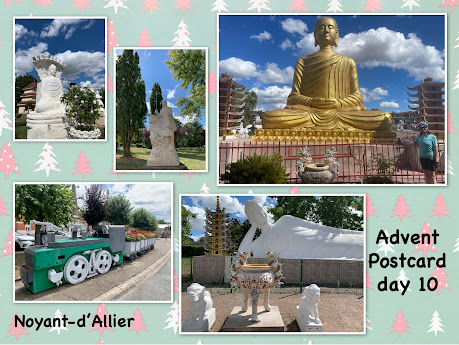 |
| Advent postcards, Noyant-d'Allier |
Advent day ten
Today’s cycling advent-ures postcard is from a small village in the Allier department we stumbled across on our two-centre cycling trip at the end of August. We spent two nights in Clermont-Ferrand and exploring the Puy de Dôme, before moving on for one night in Moulins, in the Allier department. Adrian found the village of Noyant-d’Allier, a handy thirty kilometres from Moulins, that looked a perfect spot to park the car overnight, as we unfolded the bikes and let them lead us on our adventure.
Moulins was all I’d hoped it would be, and more, as it is home to the only surviving metal railway bridge built by Jean-François Cail. Regular readers will remember he was born in Chef-Boutonne and part of the museum at the Château de Javarzay is dedicated to his remarkable life – but more about our Moulins visit in another blog. Noyant-d’Allier is the star of today’s post.
What seemed to be a standard, sleepy French village, which we’d found to be rather lacking in picnic tables, was actually hiding a huge secret that we discovered when we returned to the car, thinking our August adventure was over. We had already learned that coal mining had been important in the area, and noticed they had a small mining museum with some impressive steam trains, but it was following signs to the “Pagode” that left a lasting memory. Tucked away at the end of a residential road is a Buddhist temple, and the first thing that caught my eye was the nine-metre-high golden meditating Buddha, followed by the nine-metre-long white reclining Buddha. It felt like we had been transported a long way away from a rural mining village in France. Luckily there was an information panel explaining all (Adrian will tell you that I do love an information panel).
The coal mine had been a major employer from the middle of the 19th century until the end of World War Two, when it was fully closed in 1943. Many people left the area, so from the mid 1950’s the empty housing was used to home the refuges displaced from the French war in Indochina (Vietnam). They remained and have become an integral part in the local area, so in 1983 work began on building them a Buddhist temple, set in a park where statues illustrate the different stages of the life of Buddha, as well as a mausoleum and a garden of remembrance. I felt so lucky to have stumbled upon such a peaceful and beautiful place and was honoured to have spent a few moments wandering around.
If you are ever in the Allier department, do go and visit.

No comments:
Post a Comment
Please don't be shy, I love to hear from you.